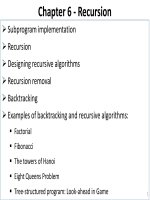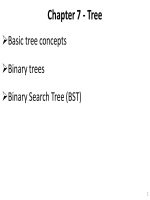Data Structures and Algorithms - Chapter 3 -Stack Applications pdf
Bạn đang xem bản rút gọn của tài liệu. Xem và tải ngay bản đầy đủ của tài liệu tại đây (382.11 KB, 37 trang )
Stack Applications
Reversing data items
Ex.: Reverse a list.
Convert Decimal to Binary.
Parsing
Ex.: Brackets Parse.
Postponement of processing data items
Ex.: Infix to Postfix Transformation.
Evaluate a Postfix Expression.
Backtracking
Ex.: Goal Seeking Problem.
Knight’s Tour.
Exiting a Maze.
Eight Queens Problem.
Reverse a list
Algorithm ReverseList
Pre User supplies numbers.
Post The numbers are printed in reverse order.
Uses Stack ADT.
1. loop (stack is not full and there is more number)
1. read a number
2. push the number into the stack
2. loop (stack is not empty)
1. top the number from the stack
2. pop stack
3. write the number
end ReverseList
2
PROBLEM: Read n numbers, print the list in reverse order.
Reverse a list
Algorithm ReverseList()
1. stackObj <Stack>
2. stackObj.Create()
3. loop (not stackObj.isFull() and there is more number)
1. read (number)
2. stackObj.Push(number)
4. loop (not stackObj.isEmpty())
1. stackObj.Top(number)
2. stackObj.Pop()
3. write (number)
5. stackObj.Clear()
end ReverseList
3
Usage of an ADT’s Object
In some compilers,
- When an object is declared, it’s default constructor (constructor without
parameters) is called to make it empty.
- Before going out of the scope, the object’s destructor is called to make it
empty.
In building an ADT library, we must consider that task: making an
object empty before it’s using and before it’s going out of the scope
by writing its default constructor and destructor.
4
In our later pseudocode, in order
to use an ADT's object, we just
declare like that
Obj <ObjType>
stackObj <Stack>
stackObj.Create()
(use stackObj in
application’s
algorithm)
stackObj.Clear()
Convert Decimal to Binary
<ErrorCode> Convert()
1. stackObj <Stack>
2. read (number)
3. loop (not stackObj.isFull() and number >0)
1. digit = number modulo 2
2. stackObj.Push(digit)
3. number = number /2
4. if (number > 0)
1. return overflow
5. else
1. loop(not(stackObj.isEmpty())
1. stackObj.Top(digit)
2. stackObj.Pop()
3. write(digit)
2. return success
5
PROBLEM: Read a decimal number and
convert it to binary.
54 2 54
D
=010110
B
0 27 2
1 13 2
1 6 2
0 3 2
1 1 2
0 0
Parsing
Parsing is any logic that breaks data into
independent pieces for further processing.
Ex. : A compiler must parse the program into
individual parts such as keywords, names, and
orther tokens.
6
Parsing
BracketParse:
Check the brackets are correctly matched or not.
7
[ A + B ] / ( C * ( D + E ) ) - { M + [ A – ( B + D) ] }
[
{
[
{
(
[
{
[
{
{
(
(
(
(
Parsing
<ErrorCode> BracketParse()
Check the brackets are correctly matched or not.
Pre None.
Post Print the results of bracket-matched checking:
(1) Unmatched closing bracket detected.
(2) Unmatched opening bracket detected.
(3) Bad match symbol.
(4) Stack is overflow.
Return failed or success.
Uses Stack ADT, function isMatched.
8
( ( A + B ) / C (2)
?
[ A + B ] / C ) (1)
( A + B ] / C (3)
?
isMatched Function
<boolean> isMatched (opening <character>, closing <character>)
Checks the brackets are matched or not.
1. Pre opening and closing is one of the brackets: (, [, {, ), ], }.
2. Post Return TRUE if both opening and closing are paired off,
FALSE otherwise.
3. Return TRUE or FALSE
9
Parsing
<ErrorCode> BracketParse()
1. stackObj <Stack>
2. loop (more data)
1. read (character)
2. if (character is an opening bracket)
1. if (stackObj.isFull())
1. write (stack overflow)
2. return failed
2. else
1. stackObj.Push(character)
3. else
10
Parsing
3. else // character is not an opening bracket
1. if (character is a closing bracket)
1. if (stackObj.isEmpty())
1. write (Unmatched closing bracket detected)
2. return failed
2. else
1. stackObj.Top(opening bracket)
2. stackObj.Pop()
3. if ( not isMatched (opening bracket, character))
1. if (not stackObj.isEmpty())
1. write (Unmatched opening bracket detected)
2. return success
11
1. write (Bad matched symbol)
2. return failed
Postponement
Ex.: 5 2 * 5 * 2 = 10
Ex.: a * b a b *
a * b + c a b * c +
a + b * c a b c * +
12
Infix to Postfix: writing the operator to the output needs to
postpone until it’s operands have been processed.
Postponement: The usage of data is deferred until
some later point.
Evaluate a Postfix Expression: all operands will not be
processed until their operator appears.
Postfix
2 4 6 + * 5 -
2 4 6 + * 5 -
2 4 6 + * 5 -
2 4 6 + * 5 -
2
4
2
6
4
2
Postfix
2 4 6 + * 5 -
2 4 6 + * 5 -
2 4 6 + * 5 -
2 4 6 + * 5 -
15
10*2 = 20
20
10
2
4+6 =10
Evaluate a Postfix Expression
5
20
20-5 = 15
Infix to Postfix Transformation
<ErrorCode> InfixToPostfix (val infix <text>, ref postfix <text>)
Transforms an infix expression to postfix.
Pre infix is a valid infix expression with operators associated from
left to right (+, -, *, /).
Post postfix has received valid postfix expression.
Return success or failed (failed when the stack is overflow).
Uses Stack ADT and function Process.
1. stackObj <Stack>
2. loop (more symbol in infix)
1. read (symbol)
2. errorCode = Process (symbol, postfix, stackObj )
3. if (errorCode = overflow)
1. return failed.
3. Pop the stack until it is empty, put all elements into postfix.
return success.
14
Infix
Postfix
Infix
Postfix
a+b*c-(d*e / f)*g
a
a+b*c-(d*e / f)*g
abc*+
a+b*c-(d*e / f)*g
a
a+b*c-(d*e / f)*g
abc*+
a+b*c-(d*e / f)*g
ab
a+b*c-(d*e / f)*g
abc*+d
a+b*c-(d*e / f)*g
ab
a+b*c-(d*e / f)*g
abc*+d
a+b*c-(d*e / f)*g
abc
a+b*c-(d*e / f)*g
abc*+de
+
+
*
+
(
-
(
-
*
+
-
*
(
-
*
(
-
Infix
Postfix
a+b*c- (d*e / f)*g
abc*+de*
a+b*c- (d*e / f)*g
abc*+de*f
a+b*c- (d*e / f)*g
abc*+de*f/
a+b*c- (d*e / f)*g
abc*+de*f/
a+b*c- (d*e / f)*g
abc*+de*f/g
/
(
-
-
/
(
-
*
-
Postfix
abc*+de*f/g*-
*
-
Process Function
<ErrorCode> Process(val symbol <char>,
ref output <text>,
ref stackObj <Stack>)
Processes the symbol depend on it’s type.
Pre symbol is one of valid symbols in an expression (operand,
operator (+, -, *, /), parenthesis symbol)
Post output and stackObj have been updated appropriately.
1. Case (symbol) of:
1. Left parenthesis: push into stackObj.
2. Right parenthesis: pop stackObj, put all elements into output
until encounter a (corresponding) left parenthesis, which is
popped but not output.
3. Operand: put into output.
17
Process Function (cont.)
<ErrorCode> Process(val symbol <char>,
ref output <text>,
ref stackObj <Stack>)
Case (symbol) of: (cont.)
4. Operator:
1. If the priority of the new operator is higher than the
priority of the operator at the top of stackObj, push it into
stackObj.
2. Otherwise, all operator at the top of stackObj, having
priority higher than or equal the new operator’s priority,
need to be pop and put into output before pushing the new
operator into stackObj.
Return overflow if stackObj is overflow, success otherwise.
18
Priority of operators
Priority of the operators associated from left to right:
Priority 2: * /
Priority 1: + -
Priority 0: (
Operators associated from right to left:
Exponent
Logarithm
The algorithm must be changed.
19
Backtracking
Common idea of backtracking:
In solving some problems, from a given position, there are some
available valid paths to go.
Only one path may be try at a time.
Others are the backtracking points to try later.
If one valid path is ended without desired solution, backtracking
allows trying through another paths systematically.
Backtracking is very suitable for problems need to find out all
solutions.
Every time one solution is found, it’s saved somewhere, and
backtracking allows continuing for the rest.
20
Goal Seeking
Goal seeking problem:
Find the path from the start node
to the destination.
Various complexity and extension
of goal seeking problem:
• Having only one start node and one destination.
• Having one start node and some destinations.
• Need to determine whether the path exists or not.
• If the path exists, show the nodes in it.
• Need to determine the cost of the path.
• The cost of the path will answer the problem not the specific destinations
• Find only one result if exists.
• Find out all results if exist.
• The graph representing the ways is acyclic or not.
• …
21
Goal Seeking (cont.)
<ErrorCode> GoalSeeking1
(val StartNode <NodeType>,
val Destination <NodeType>,
val Graph <GraphType>)
Pre Acyclic Graph has StartNode and Destination.
Post Determine whether the path from StartNode to Destination exists
or not.
Return overflow, success or failed.
Uses Stack ADT.
22
Simplest goal seeking problem:
Acyclic graph has only one start node and one destination.
Determine whether the path from start node to destination exists or not
Goal Seeking (cont.)
Algorithm GoalSeeking1
23
1
(1)
2
(2)
3
(3)
4
12
(4)
5
12
(5)
6
8
9
12
(6)
7
8
9
12
(7)
15
17
(15)
14
17
(14)
13
(13)
12
(12)
11
12
(11)
10
12
(10)
9
12
(9)
8
9
12
(8)
Destination
is found,
the path
exists.
16
17
(16)
Goal Seeking (cont.)
<ErrorCode> GoalSeeking1 (…)
1. stackObj <Stack>
2. stackObj.Push(StartNode)
3. loop ((not stackObj.isEmpty()) and (Destination is not found))
1. stackObj.Top(node)
2. stackObj.Pop()
3. if (node is not Destination)
1. Push into stackObj all node’s adjacents, if stackObj is
overflow, return overflow.
4. if (Destination is found)
1. return success
5. else
1. return failed
end GoalSeeking1
24
25
<ErrorCode> GoalSeeking2 (val StartNode <NodeType>,
val Destination <NodeType>,
val Graph <GraphType>,
ref ListOfNode <List>)
Pre Acyclic graph has StartNode and Destination.
Post If the path from StartNode to Destination exists, ListOfNode
contains the nodes in it, otherwise ListOfNode is empty.
Return overflow, success or failed.
Uses Stack ADT.
25
Another goal seeking problem:
Acyclic graph has only one start node and one destination. If the path
exists, show the nodes in it.
Goal Seeking (cont.)









